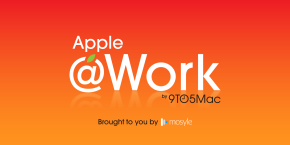
Apple @ Work is brought to you by Kandji, the MDM solution built exclusively for organizations that run on Apple. Kandji is a modern, cloud-based platform for centrally managing and securing your Mac, iPhone, iPad, and Apple TV devices, saving IT teams countless hours of manual work with features like one-click compliance templates and 150+ pre-built automations, apps, and workflows. Request access.
For the past few weeks, we’ve been working through a ‘Back to the Basics’ series around managing Apple devices in schools and enterprise organizations. As we wrap up the series this week, I want to look at accessories, AppleCare, and Apple repairs.
About Apple @ Work: Bradley Chambers has been managing an enterprise IT network since 2009. Through his experience deploying and managing firewalls, switches, a mobile device management system, enterprise-grade Wi-Fi, 100s of Macs, and 100s of iPads, Bradley will highlight ways in which Apple IT managers deploy Apple devices, build networks to support them, train users, stories from the trenches of IT management, and ways Apple could improve its products for IT departments.
Table of contents
Mac accessories
On the Mac side, there are a handful of accessories I reccomend deploying with each computer. The first thing is a USB-C hub. What ports you’ll need will depend on the desk setup of your employees, but I generally reccomend this Anker 6–1 USB C hub on the low end of the VAVA USB C Docking Station on the high end. The biggest thing you’ll need to make sure you cover is external monitor connectivity, USB-A, and ethernet (if required). I’ve personally used both of these products, and both work great.
If your employees need backup power adaptors, I’ve had great luck with the RAVPower USB-C charger and the Anker USB-C cable. They are low-cost options for secondary chargers instead of buying Apple’s first-party ones.
If you plan to use Time Machine as a local backup method, I will reccomend a USB-A model as it’s easier to come by extra USB-A ports through one of the adaptors we reccomend overusing a USB-C one.
iPad accessories
On the iPad side, the first thing is a case. If you’re deploying iPads to hundreds/thousands of people, you’ll want to be careful here that you don’t overspend on cases. It’s easy to think you need cases that can support getting ran over by a car, but you won’t need that in most situations. I reccomend something like this case as it’s a low-cost option but provides some basic protection.
If you plan for employees to use the Apple Pencil, be sure to purchase extra ones as you’ll likely have some go missing. Don’t assume everyone needs a pencil, though. Unless someone has a clear use case for it, make it something they need to add on themselves. At $99, it’s an expensive add on.
If you’re deploying the iPad Air or iPad Pro, you might want to consider the Apple Magic Keyboard if that will be your only devices for employees. Again, consider the cost, though. Buying a handful of these is one thing, but buying 100 of them will add considerable cost.
Should you buy AppleCare?
I wrote back in 2018 that I thought AppleCare+ was a terrible investment on the enterprise and K–12 side, and I still believe that today. AppleCare+ can add a large increase to your deployment cost, and statistically, you won’t need it. You will need to have a 40% damage rate to justify paying for AppleCare+ in most situations. If you have a 40% damage rate, you have other issues than broken devices. My advice is to buy an additional device for every ten you buy. So if you buy 100 iPads, buy 110 instead. If you buy 50 MacBook Airs, buy 55 instead. You’ll come out a lot cheaper and have spares to work with if damage happens. Apple includes a one-year warranty, so any defects in that first year a covered. I would include a budget for repairs from accidental damage as well, so when you have devices damaged, you have the budget to get them repaired.
Apple Repairs
When devices are under warranty, it’s preferable to let Apple handle any repairs because even accidental damage can be fixed at a lower cost. After your warranty is up, you can work with third party companies to handle iOS and Mac repairs at generally a much lower cost. Apple has official programs, so these providers are using genuine parts. 9to5Mac has partnered with iFixYouri to offer enterprise and K–12 repair services as well.
As I mentioned earlier, it’s good to have spare devices ready to go for employees/students to use while devices are being repaired, though.
Wrap up on accessories, Applecare, and repairs
Accessories, AppleCare, and repairs are not something that everyone considers when working their budget planning for their Apple deployment, but it should be factored in heavily as it’s a place where you can spend a lot of money better spent elsewhere.
FTC: We use income earning auto affiliate links. More.






Comments